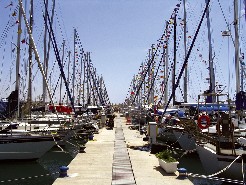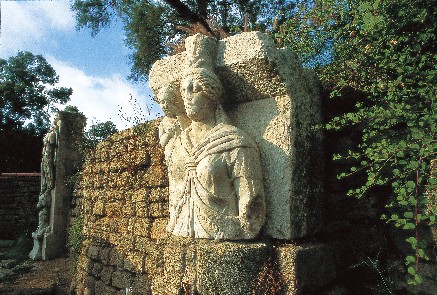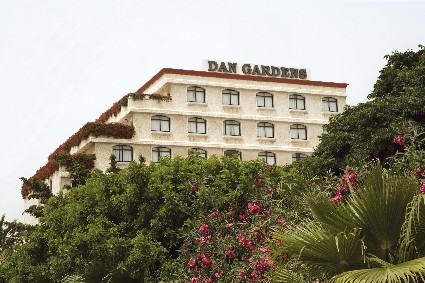|
ERETZ Magazine
|
Stayput Ashkelon
The ancient port town of
Ashkelon has been a Philistine capital, Hellenistic polis, and
fortified Crusader city. Today Ashkelon is a modern town whose
gorgeous beaches and nature reserve attract visitors from all over
Israel.
Ashkelon, which has been gaining popularity in recent years
thanks to its gorgeous beach, is more than just another beach town.
This port town is the only ancient city located on the sea coast in
the southern coastal plain. Its name is of Western-Semitic origin,
from the word shekel, which may be an allusion to one of the
Philistine tribes.
Humans first settled in Ashkelon during the Neolithic period. It was
ruled by ancient Egypt and mentioned in the El Amarna letters from
the nineteenth century BCE. It is mentioned again in the thirteenth
century BCE, when Ramses II conquered it after it rebelled against
Egypt. It also was mentioned in the Israel Astelae as a city conquered by Merneptah,
together with Gezer and Yinoam. During the Israelite Period, it was
conquered by the tribe of Judah, according to Judges 1:18, though
according to the Septuagint, Ashkelon was not captured.
mentioned in the Israel Astelae as a city conquered by Merneptah,
together with Gezer and Yinoam. During the Israelite Period, it was
conquered by the tribe of Judah, according to Judges 1:18, though
according to the Septuagint, Ashkelon was not captured.
In the twelfth century BCE, Ashkelon was conquered by its most
famous rulers, the Philistines, who also conquered the entire
southern coast of the Land of Israel. Ashkelon became one of the
five main Philistine cities and was the site where Samson killed 80
Philistines (Judges 14:19).
Excavations in Ashkelon have revealed remains from the Philistine
period, as well as from later periods, including the Hellenistic
period, when it was an independent polis. The remains of the castle
that the Crusaders built are still visible today.
(Back to top)
Bride of Syria
In Muslim tradition, Ashkelon is called Arus e-Sham (Bride of
Syria) and is one of only two cities holding this title. (Damascus
is the other.) Muslim tradition also grants Ashkelon the distinction
of being a gateway to paradise. At the time of the resurrection of the dead, according to
this tradition, 70,000 people will be resurrected in Ashkelon, each
of them free of the obligation to account for their deeds in their
lifetime.
paradise. At the time of the resurrection of the dead, according to
this tradition, 70,000 people will be resurrected in Ashkelon, each
of them free of the obligation to account for their deeds in their
lifetime.
The Muslim rulers of the land encouraged settlement in Ashkelon as a
means of defending it against the constant threat of conquest by the
Crusaders. A tradition emerged that a Muslim who spends only one day
and one night in the town can be considered a shahid, a martyr whose
entry to paradise is guaranteed, even if he dies as much as 60 years
later in another locale.
(Back to top)
Itinerary
Day 1: Around Ashkelon
Visit Ashkelon Nation Park to check out the biblical Tel Ashkelon
and finds from later periods. The most impressive remains are from
much later – the Roman Period. Then take Route 35 and drive to Beit
Guvrin for a visit to the 7,000 ancient caves and Roman and Crusader
city
(Back to top).
Day 2: Caesarea and Megiddo
Take Route 4 to Morasha Junction. Take Route 5 west to Route 2
and follow Route 2 north to Caesarea Junction. Stop at Caesarea to
tour Herod’s city on the Mediterranean, complete with a theater and
an amphitheater. Take Route 65 to Megiddo Junction, turn left, and
drive to Tel Megiddo for a visit to this ancient biblical city. Take
Route 66 north to Haifa for a visit to the Bahai Temple
(reservations required, Tel. (04) 831-3131). Then take Route 2 south
to Route 70 and take Route 70 to Zichron Ya’acov. Walk along the
main street of this settlement founded by the Baron Rothschild over
120 years ago. Have dinner at one of the many restaurants along the
mall.
(Back to top)
Day 3: Tel Aviv
Take Route 4 north to Tel Aviv. Explore Jaffa and then taste
historic Tel Aviv by strolling through Neve Tzedek and Rothschild
Boulevard. Take a lunch break on Sheinkin Street and then check out
the shops along Dizengoff Street. End the day with dinner on Ibn
Gabirol Street.
(Back to top)
Day 4: Jerusalem
Take Route 3 to Route 1 and drive to Jerusalem. Enter the Enter
the Old City via the Jaffa Gate and visit the Tower of David Museum,
whose main exhibit focuses on the history of Jerusalem. Then walk
down David Street, the main souvenir market, to the first
intersection. Turn left onto Christian Quarter Street and walk to
the alley of Saint Helena that leads down to the Holy Sepulcher.
Exit by the small entrance to the courtyard that leads to the
Muristan Market. Walk straight ahead until you reach the busy market
street of Khan e-Zeit. Turn right and walk down the ancient Crusader
markets. Once out of the market, turn left on David Street and make
your way round the corner to Sisileh Street (the Street of the
Chain). Walk down the street to the street turning to the Kotel.
Walk down to the Kotel. After visiting the Kotel, take the Rabbi
Yehudah Halevi steps up to the Jewish Quarter. Make your way through
the quarter to Zion Gate, walk out the gate, turn right, and walk
along the outside of the wall, around the corner, and back to the
Jaffa Gate.
(Back to top)
Day 5: The Dead Sea
Take Route 35 to Kiryat Gat. Take Route 40 and then Route 31 to
Arad. Descend to the Dead Sea and drive north on Route 90 to Masada.
Ascend the mountain by cable car and tour the fortress. Descend by
foot and then drive northward to visit the Ein Gedi National Park.
From the entrance to the Nahal David stream, continue to the
entrance to Nahal Arugot. Hike up Nahal Arugot to the Hidden
Waterfall. Descend to the waterfall and then hike back either along
the way that you came or along the riverbed itself through the small
Arugot Canyon. Bring a bathing suit, suitable walking shoes, a hat,
sunglasses, and plenty of water.
(Back to top)
Day 6: To the Negev
Take Routes 34 and 25 to Beersheba. Drive through Beersheba and
continue on Route 40 to the ancient town of Avdat. Tour the ruins of
this abandoned Nabatean city and then continue to Mitzpe Ramon. At
the traffic circle at the entrance to town, drive to the left along
a dirt road. The sculptures along the road all stand at the edge of
the Ramon Crater. Take a walk along the sculptures – and the massive
Ramon cliff (be careful). Return to Mitzpe Ramon and tour the
visitors’ center before making a quick visit to the alpaca farm.
Then return to Mitzpe Ramon and climb Camel Hill to watch the sun
set over the crater. Grab a quick dinner at the restaurant at the
visitors’ center and take Route 40 back to Beersheba and from there
back to Ashkelon.
(Back to top)

Dan Gardens Ashkelon
The Dan Gardens Ashkelon has long been a popular destination for
family vacations – it is comfortable, child friendly, and only
minutes from beautiful beaches, a national park rich in both
antiquities and hiking trails, and a modern marina. One of the most
exciting attractions in Ashkelon is located at the Dan Gardens
Ashkelon itself: Magic Land, a 2,000 sq.m. amusement park. Its 1,000
sq.m. outdoor section features go carts and large inflatable
structures to climb and jump on. The 400 sq.m. indoor park consists
of a series of playrooms with different themes. A room full of
trampolines and tunnels and climbing structures caters to the
energetic, while the library with books for all ages, story hours, a
large puppet theater, and cozy reading corners appeals to others. A
mini-cinema screens high-quality children’s movies and the
multimedia room has a wide selection of games. Another room, which
is set off from the rest, caters to the taste of preteens. It
includes computer stations with games and internet access, Sony
PlayStations, movies, music, and more. Though Magic Land is designed
so that children can enjoy it on their own, while their parents
enjoy the hotel’s spa and fitness center, one room of Magic Land is
dedicated to family games that parents and children can enjoy
together.
(Back to top)
|
|